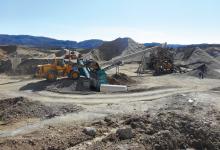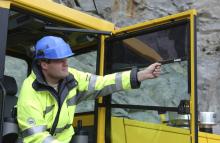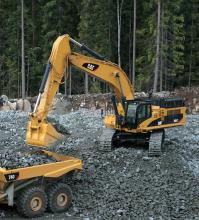
Operator comfort and wellbeing is high on the agenda for both construction equipment manufacturers and quarry operators, and introduction of the Human Vibration Directive will add a new legislative driver to the trend. Claire Symes and Mark Cherrington report
Trafficking over rough ground is almost unavoidable in a quarry or on a construction site and the vibrations this creates are a major cause of wear and tear on equipment. Manufacturers have developed better suspension systems to reduce the impact but generally the focus was on increasing the durability of the machine.
But what about wear and tear on the operator? Air conditioning, greater visibility and more space have helped improve operator comfort in recent years. But vibration also has a big impact on operators - on a day to day basis the effects can cause loss of performance but long term exposure could also pose a threat to an operator's health.
Manufacturers' attention has increasingly moved towards reducing the impact of transferred vibration - from both the machine itself and the ground it is trafficking over - on the operator. This move towards protecting operators from vibration is more than just another marketing tool - it is being driven by the Human Vibration Directive 2002/44/EC.
New legislation The Directive has been developed to ensure that all construction equipment sold within the EU provides workers with a good level of protection. The Human Vibration Directive is officially known as the "Directive 2002/44/EC of the
Assessing vibration
The action values established in the Directive have been set to provide workers with a good level of protection, but measuring and assessing the impact of vibration on the human body in an accurate and repeatable way is not straightforward.
When analysing the impact of vibration on the human body, there are several characteristics that must be taken into account. Direction, rotation, frequency, magnitude, point of entry and duration all influence how vibration is transmitted through the body and also affects how the body changes as a result.
Direction of vibration is expressed in terms of three linear axes through the body - front to back (x-axis), side to side (y-axis) and top to toe (z-axis) - and rotation is measured in terms of movement around these axes.
Frequency is usually expressed in cycles per second in hertz (Hz) and exposure to certain vibration frequencies can have a marked effect on specific parts and systems of the body, particularly if the frequency of vibration corresponds to the resonant frequency of that body part or system. For vibrations transmitted through a seat, medical research has shown that resonance in the abdomen occurs at approximately 4 to 8Hz; spinal and upper torso resonances occur at 10 to 12Hz; head and neck resonance occurs at around 30Hz; while eyes are resonant at 60-90Hz.
The magnitude of vibration is usually expressed in terms of acceleration expressed in metres per second. The absolute threshold for perception of vertical vibration for frequencies between 1 and 100Hz is approximately 0.01m/s2. Doubling of magnitude within this range will result in an approximate doubling of the sensation of discomfort.
According to ISO guidelines for passengers travelling on public transport, vibrations with a magnitude of above 0.315m/s2 will start to feel uncomfortable and the feeling of discomfort increases with the magnitude.
The latest ISO standards do provide a system for measuring vibration but interpretation of these tests and the results can vary considerably.The most vital regulations are those that establish action values (whereby certain protective procedures must be set in place) and limit values (which must never be breached). The vibration directive has single action values set at 2.5m/s2 for hand-arm vibration and 0.5m/s2 for whole-body vibration with a hand-arm limit value of 5m/s2 and a whole-body limit value of 1.15m/s2 (equivalent continuous acceleration values).
The Directive came into force for Member States on 6 July 2005 but there was a two year transitional period for new equipment, so from 6 July 2007 all new equipment must comply with the Directive. However, there is a six year transitional period for existing equipment to allow owners time to check vibration levels and if necessary retro-fit vibration attenuation systems. By July 2011 all construction equipment must meet the Directive.
"Interpretation of the Directive varies from country to country around the EU, which has led to different laws on whole body vibration being passed into law at national levels," said seating specialist Grammer senior product manager Hubert Wittmann. "Construction equipment manufacturers and OEMs have been looking at the issue and working on solutions since the Directive was first adopted in 2002." But assessing and mitigating for vibration is not a straightforward matter (see box) as the effect of vibration will vary from person to person, depending on their weight and seating position. Travel speed, machine type and terrain also have a big influence on vibration levels.
Compliance with the new Directive has led to considerable research and development work by construction equipment manufacturers and OEMs. One of the biggest difficulties facing manufacturers is that the travel speed and terrain are factors that are completely out of the manufacturers' control.
Most manufacturers have looked to further up-rate the suspension on equipment or have sought ways to isolate the cab from the rest of the machine. Seating has proved to be the key in complying with the Directive for new equipment and will also likely to be the main route for owners of existing equipment to meet the Directive.
"One of the main solutions has been to use seating with an active, rather than the conventional passive, suspension," said Wittmann. "However, adding a better seat or improved suspension does not solve the whole problem. Most solutions for reducing vibration felt by the operator create a smoother ride, which in principle may allow the machine to meet the Directive under the previous operating conditions.
"But this improvement enables operators to drive machines at higher speed and faster trafficking can be directly linked to increased vibration. The faster travel speed may result in the machine no longer meeting the requirements of the directive, so the industry may have to look at limiting speed in the future."
Reducing vibration is not the end of the story either: owners need to be able to monitor and record vibration levels to ensure the Directive is being complied with on a daily basis, not just at the point of delivery.
Not only can improved seat systems reduce transfer of vibration to the body, they can also be used to monitor vibration because most vibration passes through the body's point of contact with the machine.
US-based seating manufacturer
Future changes "So far most construction equipment manufacturers have modified existing suspensions and used seating to meet the requirements of the Directive," said Wittmann. "The machines on display at this year's
"But I expect that by Bauma 2010, manufacturers will have developed new suspension systems, not just for the axles and seats but also for the cabs, to further reduce vibration transfer. Or maybe the industry will start to create driver-less equipment to remove the impact of vibration all together?"

















